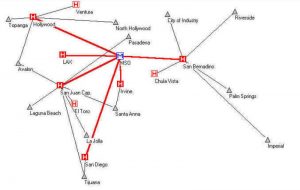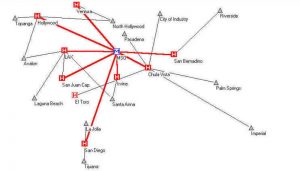Given the choice of traffic routing, link capacities and technologies which can potentially be used, it is no trivial task to determine the best way to configure a network to reliably handle offered load while keeping costs at a minimum.
PROVIDING WORLD-CLASS NETWORK OPTIMIZATION DESIGN TOOLS & RELATED PROFESSIONAL SERVICES
Our scientists are leaders with international reputations in the development and application of new methods for the design of complex network facilities, including backhaul networks for wireless traffic, local access networks, SONET ring networks, optical networks, international transit networks, and interconnection networks between local and interexchange carriers. We have unique capability to solve detailed traffic routing and scheduling problems simultaneously with the overall network architecture and capacity planning problems, so that we can specify how best to use the facilities we design. Many of these problems are known to be theoretically unsolvable in practical amounts of time. We have pioneered the successful practical applications of heuristic techniques such as genetic algorithms to obtain optimal or near-optimal results. To learn more about the techniques we use, see our Mathematical Optimization page or read our paper on a specific example of Backhaul Network Optimization and Minimizing the Cost of Wireless Switch Capacity Expansion.
In the network pictured in Figure 1 below, the nodes that generate traffic are shown as triangles, those that are candidates to be digital hubs, capable of consolidating traffic, are shown as boxes with the letter “H” inside, and the switch is shown as a box with an “M” inside. The thin lines are DS1 circuits and the heavy lines are DS3s. For each node, the type of node and the demand can be indicated. The cost data, for link choices, is also provided. Given the demand and the potential network design, our optimization program calculates the best routing of traffic and establishment of hubs to serve the demand. Figure 1 represents the original network, before optimization for increasing demand.


Figure 2 illustrates a network which has been optimized to serve increased demand cost effectively. Note that in Figure 2 demand has been rerouted to better utilize hubs, more completely filling DS3 circuits. In many cases the routing of traffic may be somewhat counter-intuitive. The power of mathematical modeling can spot the solution that is most cost effective and may otherwise have been missed! The important fact to understand is that the least costly solution may not always be obvious. We at Cox Associates would be delighted to demonstrate our technology to you and prove that we can, as we consistently have, save you from 10% to 40% on your network costs. We can not only optimize your network as it is now, but we can also provide you tools and techniques to ensure that your network remains as cost effective over time as demand patterns grow and shift.
REDUCING COSTS
Network operating costs often dominate both capital and operating expenses for a telecommunications provider. Given a choice of traffic routing, link capacities and technologies which can potentially be used, it is no trivial task to determine the best way to configure a network to reliably handle offered load while keeping costs at a minimum.
Rigorous mathematical techniques can help achieve the least costly network design to meet demand and provide high quality service. Practical network optimization software and heuristics are specialties of Cox Associates. Some examples of network optimization software tools developed by Cox Associates since 1996 include:
- Leased LEC-facilities backhaul network design for Cellular and PCS networks;
- Merging existing and newly acquired network facilities;
- PCS switch capacity optimization and capacity expansion planning;
- Switch load growth forecasting;
- Optimal equipment deployment for legacy and next-generation transport networks.
Benefits of Optimization
- Minimize the cost of your network now and over time.
- Provide the level of reliability and survivability you choose.
- Serve a growing customer base through a higher quality of service.
Related Publications
- Cox, LA, Jr., J.R. Sanchez, and Lu, L., 2001. Cost savings from optimized packing and grooming of optical circuits: Mesh vs. ring comparisons. Optical Networks Magazine, May-June, 72-90.
- Cox, LA, Jr., J. Sanchez “Cost Savings from Network Optimization of DWDM Facilities and Optical Switches.”
- Cox, LA, Jr., G. Fischer”Optical Network Design Tools: Optimization Software to Support Migrating to All-Optical Networks.”
- Cox, LA, Jr., and J.R. Sanchez, 2000. Designing least-cost survivable wireless backhaul networks. Journal of Heuristics, 6, 525-540.
- Cox, LA, Jr., J. Sanchez “Reducing Cost of Backhaul Networks for PCS Traffic Using Genetic Algorithms.”
- Cox, LA, Jr., W. Kuehner “Dynamic Hierarchical Packing of Wireless Switches Using a Seed, Repair and Replace Genetic Algorithm.”
